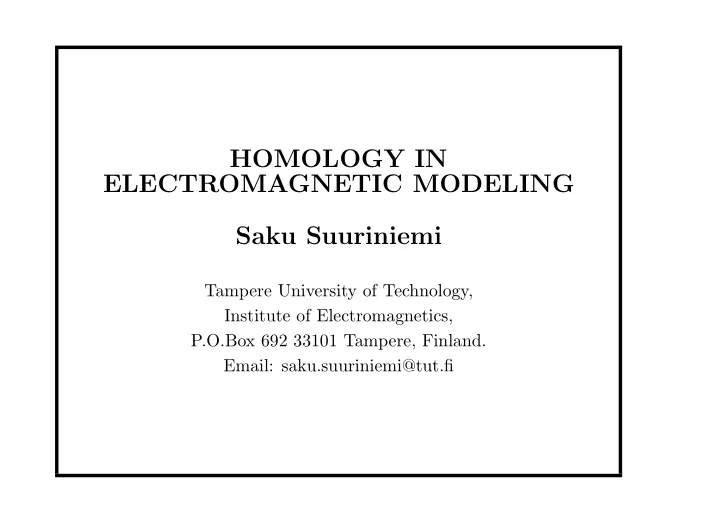

HOMOLOGY IN ELECTROMAGNETIC MODELING Saku Suuriniemi Tampere University of Technology, Institute of Electromagnetics, P.O.Box 692 33101 Tampere, Finland. Email: saku.suuriniemi@tut.fi
1 Intro • Electromagnetic modeling involves solutions of PDE-BVP’s on Maxwell’s equations. • Typical quasi-static electromagnetic BVP over domain Ω (Riemann manifold with boundary): – First order PDE’s (Maxwell) d h = j, d b = 0 – Constitutive equation(s) b = ∗ µ h – Boundary conditions for disjoint Γ 1 , Γ 2 , where ∂ Ω = Γ 1 + Γ 2 holds. t h = 0 on Γ 1 , t b = 0 on Γ 2
• May not have unique solution: – d h = 0 applies in Ω ( h is closed ), but does not determine � circulation c h over the dashed 1-chain c . I c c c S Ω Ω Ω t h = 0 � � � c h = 0 c h = I c h = 0 – However, boundary condition t h = 0 on S does. • In first and last h can be exact , i.e. admit potential h = d ψ .
2 Analysis Did B.C. really zero out circulations outside S ? • Consider circulation known over Γ 1 . S Γ 1 Γ 2 • Then for any ∂S , � � � � � � h = h − h = h − d h = h Γ 1 − ∂S Γ 1 ∂S Γ 1 S Γ 1 � � holds by theorem ∂S h = S d h and d h = 0.
� � Yes: if B.C. makes Γ 1 h = 0, then Γ 1 + ∂S h = 0 for any S , too • Identical circulations ⇒ ignore difference: c and c + ∂S belong to the same equivalence class [ c ] for any S . – Division of 1- chains c ∈ C 1 (Ω) into homology cosets H 1 (Ω) = ker( ∂ 1 ) /∂ 2 ( C 2 (Ω)) = (1-cycles)/(1-boundaries). – H 1 (Ω) topological , invariant under homeomorphisms of Ω. Circulation must be known for each generator of H 1 (Ω)
• Scalar potential spells “speed” � If c h = 0 ∀ [ c ] ∈ H 1 (Ω), is closed 1-form h exact? • de Rham: For H 1 dR (Ω) = (closed 1-forms) / (exact 1-forms) and dR (Ω) ∼ H 1 (Ω), isomorphism H 1 = H 1 (Ω) holds. Yes: only nonzero circulations prohibit potentials � • Criterion: closed h exact, if c h = 0 for all cycles c . In practice, check only generators of H 1 (Ω) ! • Procedure: 1. Find H 1 (Ω) 2. Find circulations set by B.C.’s and impose the rest 3. Scalar potential for fields whose all circulations vanish
3 Example (concerns relative homology) • In resistor, PDE’s d e = 0 , d j = 0 hold with Ohm’s law j = ∗ σ e and boundary conditions t e = 0 at ends and t j = 0 at side. c S � � • No unique solution unless U = c e or I = S j is known (elements of H 1 (Ω , ends) , H 2 (Ω , side)).
• Traditional strategy: Adopt potential e = d ϕ and pose U as potential difference. c S
4 Application • Homology groups useful in posing and checking problems. • Riemannian manifold makes computation possible. – FEM mesh needed ⇒ finitely generated chain groups. – Cheap enough in practice. • Options in everyday modeling software: 1. Automatic exhaustive checking: Compute automatically all homology groups, check that boundary conditions and sources are consistent. Complain for missing or conflicting conditions. 2. Checklist: Automatically produce homology groups (relevant ones), user verifies that appropriate conditions set. 3. Toolbox: Groups computed upon request.
Recommend
More recommend